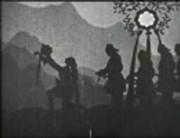Review of "Kokumin Kimigayo": Digging deeper into the fusion of history and music

"Kokumin・Kimigayo": Screen Music that Colored the Dawn of Japanese AnimationOverview"Kokumin・Kimigayo" is a Japanese animation released on January 1, 1930, and its media is classified as "other." The original work is an original anime, and was produced by Yokohama Cinema Shokai. The work is a short one-episode story of just four minutes. When it was released, it was called "Japan's first screen music," and attracted a lot of attention. Production background and technology"Kokumin Kimigayo" is a work that combines live action and animation, and is a noteworthy presence in the history of Japanese animation films at the time. In the work, iconic Japanese landscapes such as Ise Shrine, Futamiura, and Mount Fuji are shown in live action, and a white ball (bouncing ball) moves along a musical scale on a staff. This technique is thought to have been inspired by Max Fleischer's 1929 work "Ye Olden Melodie's." Significance and influence of the work"Kokumin Kimigayo" was produced at a time when Japanese animation was still in its infancy, and its technical experiments had a major influence on later animation production. In particular, the screen music format was accepted as a new form of entertainment that stimulated both the senses of sight and sound at the same time, and became an example of the importance of music in later animation works. It is also thought that this work, by combining traditional Japanese scenery with music, had the effect of enhancing the patriotism of the people. Detailed explanation■Explanation"Kokumin・Kimigayo" is a work that skillfully combines live action and animation, and was advertised at the time as "Japan's first screen music." In the work, iconic Japanese landscapes such as Ise Shrine, Futamiura, and Mount Fuji are shown in live action, and a white ball (bouncing ball) moves along a musical scale on a staff. This technique is thought to have been inspired by Max Fleischer's 1929 work "Ye Olden Melodie's." Source: History of Japanese Animation Films, p. 201 Recommendations and ratingsThough short, "Kokumin Kimigayo" is a must-see for modern animation enthusiasts and history scholars due to its technical innovation and cultural significance. It should be especially praised for being the first Japanese film to use the screen music format, and it is a work that symbolizes the progress of Japanese animation technology at the time. Furthermore, by combining traditional Japanese scenery with music, this film succeeds in making a strong impression on the viewer both visually and aurally. Related works and recommendation listIf you are interested in "Kokumin Kimigayo," we also recommend the following related works. These works also offer a fusion of early animation techniques and music.
summary"Kokumin Kimigayo" is a Japanese animation released in 1930, and is a work that should be highly appreciated even today for its technical innovation and cultural significance. It is particularly noteworthy that it was the first Japanese film to adopt the screen music format, and that by combining traditional Japanese scenery with music, it left a strong impression on viewers both visually and aurally. This work is one that marks the dawn of Japanese animation, and is one that should be seen by many people. |
<<: The appeal and reviews of "Denrin": You can't miss it!
>>: Taro's Adventure Filming: A Perfect Combination of Visual Beauty and Storytelling
Recommend
20th Century Hour's "The Making of an Undersea City" Review: Exploring the Dreams and Reality of Future Cities
20th Century Hour "Until the Undersea City i...
Ahare! Meisaku-kun Season 2 - A thorough review of the highly anticipated sequel
The appeal and evaluation of the second season of...
Cassie Clare to play Philippa in The Witcher season 2
Today (March 17), Netflix's live-action serie...
The appeal and evaluation of "Lance N' Masques": An in-depth review
"Lances and Masques": The truth and adv...
Spider-Man 4 is rumored to start filming at the end of 2023 and be released in 2025
According to Spider-Man: Updates, a Spider-Man in...
Tanaka-kun's Listless Daily Life: Review of charming characters and humorous story
"Tanaka-kun is Always Listless" - Findi...
CJ 2019: DC and Batman appear at CJ 15-second wonderful video preview
Today (August 3), ChinaJoy officially confirmed t...
Kanna Hashimoto's performance was so hard that the scene in "I'm the Big Brother" scared the children to tears
Recently, Japanese idol singer and actress Kanna ...
The appeal and reviews of "Mr. Penpen": A thorough analysis of the unique characters and depth of the story
The appeal and reviews of "Mr. Penpen":...
The appeal and reviews of Mahou Sensei Negima! ~Another World~: The world of anime seen from a new perspective
Mahou Sensei Negima! ~Another World~: New adventu...
"Detective Conan" 2023 movie trailer released, Haibara drowned in the sea and called for help
Toho today released a special trailer for the 202...
Poppoyasan and the Carefree Stationmaster - What is the appeal of this heartwarming anime that depicts soothing everyday life?
"Poppoyasan: The Carefree Stationmaster"...
Japanese media commented on the live-action version of "Demon Slayer: Kimetsu no Yaiba" Tanjiro & Nezuko's choice Kento Kanna's strength topped the list
Although the extremely popular manga "Demon ...
Arcana Famiglia Special Disc La prima festa - A thorough review of the disc packed with luxurious bonuses that fans must see!
Arcana Famiglia Special Disc La prima festa - A d...
The appeal and reviews of "BUS GAMER": A thorough analysis of the thrilling survival game
BUS GAMER - Biz Gamer - All-round information and...









